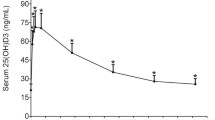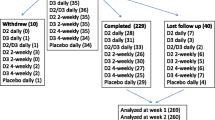Abstract
Purpose
To determine the dose–response of vitamin D3 supplementation on serum 25-hydroxyvitamin D [25(OH)D] among Chinese adults.
Methods
In this 5-arm, randomized, double-blinded controlled trial, 76 healthy participants were assigned to orally administrate 0, 400, 800, 1200 or 2000 IU/d of vitamin D3 for 16 weeks. Serum 25(OH)D, parathyroid hormone, calcium, biomarkers of liver and renal function were measured at multiple time points.
Results
The mean (SD) serum 25(OH)D at baseline was 31.6 (8.7) nmol/L, and the dose–response relationship was curvilinear with a plateau around 6 weeks for all doses. At week 16, 25(OH)D was increased by 6.0 (6.5), 21.7 (15.8), 26.3 (12.6), 32.0 (12.8) and 36.3 (26.0) nmol/L for 0, 400, 800, 1200 and 2000 IU/d (all P ≤ 0.002), corresponding to approximately 19, 53, 67, 77 and 80 % of reversion of vitamin D deficiency, respectively. Daily intake of 800 IU vitamin D3 reached a targeted 25(OH)D ≥ 30 nmol/L in at least 97.5 % of Chinese, but not a targeted 25(OH)D ≥ 50 nmol/L even with 2000 IU/d. Change of 25(OH)D was inversely associated with change of PTH concentration (r = −0.39, P < 0.001) after controlling for age and sex. No between-group differences were observed in terms of the change in serum calcium, alanine transaminase, aspartate aminotransferase, gamma-glutamyltransferase and creatinine (P ≥ 0.22).
Conclusions
Supplementation with 400, 800, 1200 or 2000 IU/d vitamin D could improve the vitamin D deficiency with various degrees. Whether 2000 IU/d vitamin D3 would generate a better result without side effect requires more studies with larger samples in future.



Similar content being viewed by others
Abbreviations
- 25(OH)D:
-
25-Hydroxyvitamin D
- ALT:
-
Alanine transaminase
- AST:
-
Aspartate aminotransferase
- BMI:
-
Body mass index
- DBP:
-
Diastolic blood pressure
- GGT:
-
Gamma-glutamyltransferase
- PTH:
-
Parathyroid hormone
- SBP:
-
Systolic blood pressure
References
Holick MF (2007) Vitamin D deficiency. N Engl J Med 357:266–281. doi:10.1056/NEJMc072359
Lu L, Yu Z, Pan A, Hu FB, Franco OH, Li H, Li X, Yang X, Chen Y, Lin X (2009) Plasma 25-hydroxyvitamin D concentration and metabolic syndrome among middle-aged and elderly Chinese individuals. Diabetes Care 32:1278–1283. doi:10.2337/dc09-0209
Choi HS, Oh HJ, Choi H, Choi WH, Kim JG, Kim KM, Kim KJ, Rhee Y, Lim S-K (2011) Vitamin D insufficiency in Korea-a greater threat to younger generation: the Korea National Health and Nutrition Examination Survey (KNHANES) 2008. J Clin Endocrinol Metab 96:643–651. doi:10.1210/jc.2010-2133
Thomas MK, Lloyd-Jones DM, Thadhani RI, Shaw AC, Deraska DJ, Kitch BT, Vamvakas EC, Dick IM, Prince RL, Finkelstein JS (1998) Hypovitaminosis D in medical inpatients. N Engl J Med 338:777–783. doi:10.1056/NEJM199803193381201
Holick MF (2006) High prevalence of vitamin D inadequacy and implications for health. Mayo Clin Proc 81:353–373. doi:10.4065/81.3.353
Chapuy MC, Preziosi P, Maamer M, Arnaud S, Galan P, Hercberg S, Meunier PJ (1997) Prevalence of vitamin D insufficiency in an adult normal population. Osteoporos Int 7:439–443. doi:10.1007/s001980050030
Bakhtiyarova S, Lesnyak O, Kyznesova N, Blankenstein MA, Lips P (2006) Vitamin D status among patients with hip fracture and elderly control subjects in Yekaterinburg, Russia. Osteoporos Int 17:441–446. doi:10.1007/s00198-005-0006-9
Lips P (2006) Vitamin D physiology. Prog Biophys Mol Bio 92:4–8. doi:10.1016/j.pbiomolbio.2006.02.016
Scragg R, Sowers M, Bell C (2004) Serum 25-hydroxyvitamin D, diabetes, and ethnicity in the third national health and nutrition examination survey. Diabetes Care 27:2813–2818. doi:10.2337/diacare.27.12.2813
Mosayebi G, Ghazavi A, Ghasami K, Jand Y, Kokhaei P (2011) Therapeutic effect of vitamin D3 in multiple sclerosis patients. Immunol Investig 40:627–639. doi:10.3109/08820139.2011.573041
Gagnon C, Lu ZX, Magliano DJ, Dunstan DW, Shaw JE, Zimmet PZ, Sikaris K, Ebeling PR, Daly RM (2012) Low serum 25-hydroxyvitamin D is associated with increased risk of the development of the metabolic syndrome at five years: results from a national, population-based prospective study (The Australian Diabetes, Obesity and Lifestyle Study: AusDiab). J Clin Endocrinol Metab 97:1953–1961. doi:10.1210/jc.2011-3187
Forouhi NG, Luan Ja, Cooper A, Boucher BJ, Wareham NJ (2008) Baseline serum 25-hydroxy vitamin D is predictive of future glycemic status and insulin resistance: the medical research council ely prospective study 1990–2000. Diabetes 57:2619–2625. doi:10.2337/db08-0593
Forman JP, Scott JB, Ng K, Drake BF, Suarez EG, Hayden DL, Bennett GG, Chandler PD, Hollis BW, Emmons KM, Giovannucci EL, Fuchs CS, Chan AT (2013) Effect of vitamin D supplementation on blood pressure in blacks. Hypertension 61:779–785. doi:10.1161/HYPERTENSIONAHA.111.00659
Chiu KC, Chu A, Go VLW, Saad MF (2004) Hypovitaminosis D is associated with insulin resistance and beta cell dysfunction. Am J Clin Nutr 79:820–825
Chacko SA, Song Y, Manson JE, Van Horn L, Eaton C, Martin LW, McTiernan A, Curb JD, Wylie-Rosett J, Phillips LS, Plodkowski RA, Liu S (2011) Serum 25-hydroxyvitamin D concentrations in relation to cardiometabolic risk factors and metabolic syndrome in postmenopausal women. Am J Clin Nutr 94:209–217. doi:10.3945/ajcn.110.010272
Choi HS, Kim K-A, Lim C-Y, Rhee SY, Hwang Y-C, Kim KM, Kim KJ, Rhee Y, Lim S-K (2011) Low serum vitamin D is associated with high risk of diabetes in Korean adults. J Nutr 141:1524–1528. doi:10.3945/jn.111.139121
Ross AC, Manson JE, Abrams SA, Aloia JF, Brannon PM, Clinton SK, Durazo-Arvizu RA, Gallagher JC, Gallo RL, Jones G, Kovacs CS, Mayne ST, Rosen CJ, Shapses SA (2011) The 2011 report on dietary reference Intakes for calcium and vitamin D from the institute of medicine: what clinicians need to know. J Clin Endocrinol Metab 96:53–58. doi:10.1210/jc.2010-2704
Wang TJ, Zhang F, Richards JB et al (2010) Common genetic determinants of vitamin D insufficiency: a genome-wide association study. Lancet 376:180–188. doi:10.1016/S0140-6736(10)60588-0
Zittermann A, Ernst J, Gummert J, Borgermann J (2014) Vitamin D supplementation, body weight and human serum 25-hydroxyvitamin D response: a systematic review. Eur J Nutr 53:367–374. doi:10.1007/s00394-013-0634-3
Raimundo F, Lang M, Scopel L, Marcondes N, Araújo M, Faulhaber G, Furlanetto T (2014) Effect of fat on serum 25-hydroxyvitamin D levels after a single oral dose of vitamin D in young healthy adults: a double-blind randomized placebo-controlled study. Eur J Nutr. doi:10.1007/s00394-014-0718-8
Gallagher JC, Sai A, Templin T 2nd, Smith L (2012) Dose response to vitamin D supplementation in postmenopausal women: a randomized trial. Ann Intern Med 156:425–437. doi:10.7326/0003-4819-156-6-201203200-00005
Wang TJ, Pencina MJ, Booth SL, Jacques PF, Ingelsson E, Lanier K, Benjamin EJ, D’Agostino RB, Wolf M, Vasan RS (2008) Vitamin D deficiency and risk of cardiovascular disease. Circulation 117:503–511. doi:10.1161/CIRCULATIONAHA.107.706127
Kendrick J, Targher G, Smits G, Chonchol M (2009) 25-hydroxyvitamin D deficiency is independently associated with cardiovascular disease in the third national health and nutrition examination survey. Atherosclerosis 205:255–260. doi:10.1016/j.atherosclerosis.2008.10.033
Ng K, Scott JB, Drake BF, Chan AT, Hollis BW, Chandler PD, Bennett GG, Giovannucci EL, Gonzalez-Suarez E, Meyerhardt JA, Emmons KM, Fuchs CS (2014) Dose response to vitamin D supplementation in African Americans: results of a 4-arm, randomized, placebo-controlled trial. Am J Clin Nutr 99:587–598. doi:10.3945/ajcn.113.067777
Blum M, Dolnikowski G, Seyoum E, Harris S, Booth S, Peterson J, Saltzman E, Dawson-Hughes B (2008) Vitamin D3 in fat tissue. Endocrine 33:90–94. doi:10.1007/s12020-008-9051-4
Ye X, Yu Z, Li H, Franco OH, Liu Y, Lin X (2007) Distributions of C-reactive protein and its association with metabolic syndrome in middle-aged and older Chinese people. J Am Coll Cardiol 49:1798–1805. doi:10.1016/j.jacc.2007.01.065
Lai JKC, Lucas RM, Banks E, Ponsonby AL, Ausimmune Investigator G (2012) Variability in vitamin D assays impairs clinical assessment of vitamin D status. Intern Med J 42:43–50. doi:10.1111/j.1445-5994.2011.02471.x
Hathcock JN, Shao A, Vieth R, Heaney R (2007) Risk assessment for vitamin D. Am J Clin Nutr 85:6–18
Barrett-Connor E, Siris ES, Wehren LE, Miller PD, Abbott TA, Berger ML, Santora AC, Sherwood LM (2005) Osteoporosis and fracture risk in women of different ethnic groups. J Bone Miner Res 20:185–194. doi:10.1359/JBMR.041007
Gutierrez OM, Farwell WR, Kermah D, Taylor EN (2011) Racial differences in the relationship between vitamin D, bone mineral density, and parathyroid hormone in the national health and nutrition examination survey. Osteoporos Int 22:1745–1753. doi:10.1007/s00198-010-1383-2
Jarrett F, Michelle Ducasa G, David BB, Berwick M (2014) The effect of oral supplementation of vitamin D3 on serum levels of vitamin D: a review. Epidemiology 4:148. doi:10.4172/2161-1165.1000148
Smith SM, Gardner KK, Locke J, Zwart SR (2009) Vitamin D supplementation during Antarctic winter. Am J Clin Nutr 89:1092–1098. doi:10.3945/ajcn.2008.27189
Talwar SA, Aloia JF, Pollack S, Yeh JK (2007) Dose response to vitamin D supplementation among postmenopausal African American women. Am J Clin Nutr 86:1657–1662
Mitchell D, Henao M, Finkelstein J, Burnett-Bowie S-A (2012) Prevalence and predictors of vitamin D deficiency in healthy adults. Endocr Pract 18:914–923. doi:10.4158/EP12072.OR
Sasaki S (2008) Dietary reference intakes (DRIs) in Japan. Asia Pac J Clin Nutr 17:420–444
Paik HY (2008) Dietary reference intakes for Koreans (KDRIs). Asia Pac J Clin Nutr 17:416–419
Chinese Nutrition Society (2014) Dietary Reference intakes (DRIs) in Chinese (2013). Science Press (CN)
Awumey EMK, Mitra DA, Hollis BW, Kumar R, Bell NH (1998) Vitamin D metabolism is altered in Asian Indians in the Southern United States: a clinical research center study. J Clin Endocrinol Metab 83:169–173. doi:10.1210/jc.2007-2308
Holick MF, Biancuzzo RM, Chen TC, Klein EK, Young A, Bibuld D, Reitz R, Salameh W, Ameri A, Tannenbaum AD (2008) Vitamin D2 is as effective as vitamin D3 in maintaining circulating concentrations of 25-hydroxyvitamin D. J Clin Endocrinol Metab 93:677–681. doi:10.1210/jc.2007-2308
Gallagher JC, Peacock M, Yalamanchili V, Smith LM (2013) Effects of vitamin D supplementation in older African American women. J Clin Endocrinol Metab 98:1137–1146. doi:10.1210/jc.2012-3106
Gallagher JC, Jindal PS, Smith LM (2014) Vitamin D supplementation in young white and african american women. J Bone Miner Res 29:173–181. doi:10.1002/jbmr.2010
Ross AC, Taylor CL, Yaktine AL, Valle. HBD (2011) Dietary reference intakes for calcium and vitamin D. National Academies Press (US)
Holick MF (2004) Sunlight and vitamin D for bone health and prevention of autoimmune diseases, cancers, and cardiovascular disease. Am J Clin Nutr 80:1678S–1688S
Lips P (2001) Vitamin D deficiency and secondary hyperparathyroidism in the elderly: consequences for bone loss and fractures and therapeutic implications. Endocr Rev 22:477–501
Acknowledgments
This study was supported by Ministry of Science and Technology of China [2013BAI04B03], and the National Natural Science Foundation of China [81170734, 81321062]. The authors’ responsibilities were as follows: P. Y. and L. L., conducted research, performed statistical analysis and wrote the paper; Y. H., G. L., X. C., L. S., X. Y. and H. Z. conducted research; Y. C. and F. B. H contributed to data analysis and interpretation and edited the paper; H. L. and X. L. designed the study, conducted research and had primary responsibility for the final content. All authors reviewed and approved the final manuscript. We give our sincere thanks to Lixin Tang for the devotion during field work, Yiqing Song for advice during the manuscript preparation and especially to Dr. Walter Willett for his helpful comments. We further appreciate the strong support shown by Xiamen Xingsha Pharmaceutical Group Co., Ltd. Finally, the greatest thanks should be given to all the participants involved in this study.
Conflict of interest
The authors declare that there is no conflict of interest.
Author information
Authors and Affiliations
Corresponding author
Additional information
Pang Yao and Ling Lu have contributed equally to this article.
Electronic supplementary material
Below is the link to the electronic supplementary material.
Rights and permissions
About this article
Cite this article
Yao, P., Lu, L., Hu, Y. et al. A dose–response study of vitamin D3 supplementation in healthy Chinese: a 5-arm randomized, placebo-controlled trial. Eur J Nutr 55, 383–392 (2016). https://doi.org/10.1007/s00394-015-0859-4
Received:
Accepted:
Published:
Issue Date:
DOI: https://doi.org/10.1007/s00394-015-0859-4




